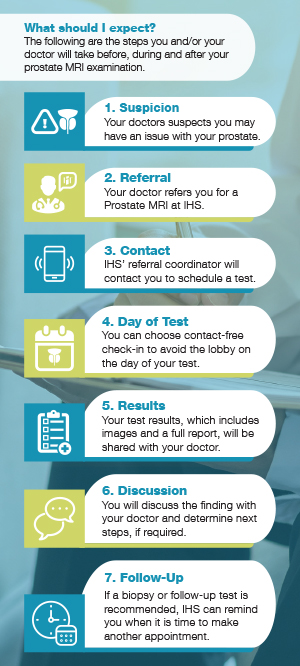Here’s a more in depth look into what you can expect during this process.
1. Your doctor suspects a prostate issue
You may have an elevated or rising PSA. You may have had an abnormal rectal examination. Or, your doctor may be looking at a combination of factors such as your family history, ethnicity, weight, age or other risk factors. At this point, your doctor may recommend that you have a prostate MRI examination at Imaging Healthcare Specialists (IHS).
2. You receive a referral to IHS
If you and your doctor agree that a prostate MRI test is right for you, you will receive a referral from your doctor that is sent to our scheduling department. This means that your doctor has recommended this test to help determine if the prostate “issue” is caused by cancer, or if it is the result of a benign condition, such as an enlarged prostate (also called BPH) or prostatitis (inflammation).
3. You will be contacted by an IHS Patient Concierge
When IHS receives the referral, our Patient Concierge will reach out to you by phone within 24-48 hours to schedule your prostate MRI examination. They will schedule your exam at a time that works for your schedule, inform you about how long the exam will take, and provide directions to which location your test will take place. Prior to your arrival, you will be give preparation instructions, along with a time to arrive at the center. As part of your preparation, you will be asked not to eat any food 6 hours prior to your appointment time, and to drink plenty of water to stay well hydrated the day of the exam.
4. On the day of your appointment
If you choose contact-free check in, you will be contacted 2-3 hours prior to your test to fill out any forms that may be needed online. If you choose this option, you will bypass the waiting room and will be taken directly to the MRI suite. The test itself takes less than an hour. The technologist will inform you what to expect, and be in audio contact while you are inside the MRI machine. If you have any questions, the IHS radiologist will be on hand to answer them. The radiologist is a medical doctor specialized in diagnostic imaging who will consult with you and your doctor about your test results.
5. Test results
Your doctor will receive a detailed report with your prostate MRI findings. In some cases, the test will reveal no prostate cancer, and possibly identify another condition causing your prostate issue. Your doctor may recommend medication or lifestyle changes, and monitor biomarkers to help ensure that your PSA levels or risk factors are reduced. In some cases, it will reveal the presence of cancer. The radiologist may be able to assess the nature of the cancer and work with your doctor to determine if a prostate biopsy is needed.
6. Discussion with your doctor
After your prostate MRI, you will likely be called in for a consultation with your doctor. If a small cancer was found, you may be advised to take no action today but monitor the disease over time. If a more aggressive form of cancer is suspected, a biopsy will be recommended.
7. Follow-up testing
For men with slow-growing cancers, a strategy of “active surveillance” is often recommended. This means that your doctor does not think cancer treatment is needed at this time, but that your prostate gland should be monitored. You will likely have another prostate MRI at a prescribed interval—6, 12 or 24 months after your first MRI. By monitoring the progression, your doctor can assess changes in your prostate gland to help determine if treatment for prostate cancer is required.



